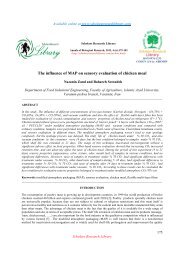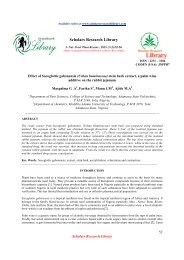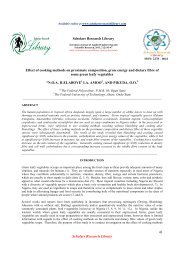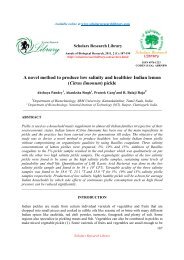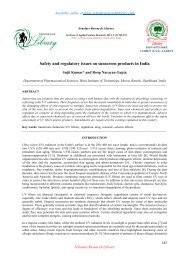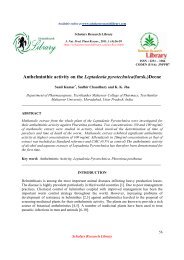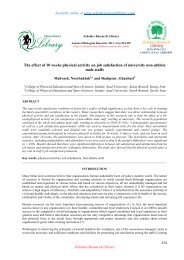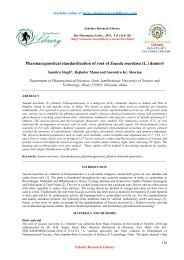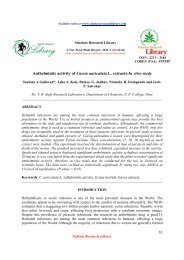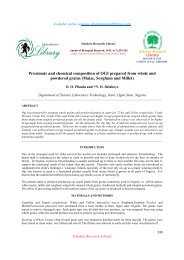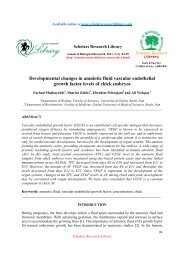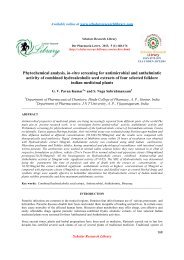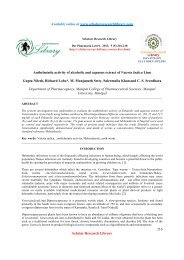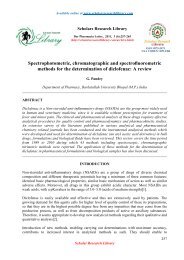Scholars Research Library Geophysical investigation of effects of ...
Scholars Research Library Geophysical investigation of effects of ...
Scholars Research Library Geophysical investigation of effects of ...
Create successful ePaper yourself
Turn your PDF publications into a flip-book with our unique Google optimized e-Paper software.
Available online at www.scholarsresearchlibrary.com<br />
<strong>Scholars</strong> <strong>Research</strong> <strong>Library</strong><br />
Archives <strong>of</strong> Physics <strong>Research</strong>, 2010, 1 (3):62-71<br />
(http://scholarsresearchlibrary.com/archive.html)<br />
ISSN 0976-0970<br />
CODEN (USA): APRRC7<br />
<strong>Geophysical</strong> <strong>investigation</strong> <strong>of</strong> <strong>effects</strong> <strong>of</strong> topographic complexities on<br />
groundwater potential in Ibusa, Delta State Nigeria<br />
Emmanuel C. Okolie<br />
Department <strong>of</strong> Physics, Delta State University Abraka, Nigeria<br />
______________________________________________________________________________<br />
ABSTRACT<br />
Ibusa is situated a few kilometres from the River Niger near Delta State capital, Asaba. .Despite<br />
its nearness to the course <strong>of</strong> River Niger, it is positioned on a cliff which makes the acquisition <strong>of</strong><br />
groundwater a serious problem for the inhabitants. It marks a transition point from the river<br />
bank to the hinterland and between geological formations. It is therefore, necessary to carry out<br />
geophysical survey within and around Ogboli, Ezukwu and Achala in Ibusa to determine the<br />
topographic complexities and their <strong>effects</strong>. Thus, ten VES soundings were made using<br />
Schlumberger array with a sensitive SAS 1000 terrameter. The results show that virtually all<br />
sites in the study area exhibit A – type curve. They also indicate that while Ogboli and Ezukwu<br />
villages have typically deep aquifers enclaved by deep rooted rocks, neighbouring Achala village<br />
is a low land zone with shallow aquifer. In addition Ogboli and Ezuikwu villages consist <strong>of</strong> thick<br />
lateritic top soil to about 10 m, remarkable weathered rocks <strong>of</strong> high iron content at shallow<br />
depths <strong>of</strong> 15 – 18 m and a thick formation <strong>of</strong> hard granite at far depth. False aquifers exist at<br />
shallow depths <strong>of</strong> 30 – 40 m while viable aquifer is at 80 – 110 m. On the other hand, Achala<br />
possess loose top soil to considerable depth followed by a thin layer <strong>of</strong> lateritic soil, a layer <strong>of</strong><br />
medium to gravely sand and viable aquifer at about 30 – 40 m<br />
Key words: Topographic complexities, Schlumberger, formations, aquifers, Ibusa Nigeria.<br />
______________________________________________________________________________<br />
INTRODUCTION<br />
The problem <strong>of</strong> potable water for domestic and industrial utilities has generally been an age long<br />
issue in Ibusa despite its nearness to Asaba, the bank <strong>of</strong> river Niger where groundwater is easily<br />
obtained. A number <strong>of</strong> boreholes have been dug in Ibusa without success. In some cases many<br />
trial wells are drilled before seeming success is achieved in Ogboli and Eziukwu villages for<br />
example. However, this problem does not exist in Achala which is about 2 km away. This work<br />
suggests that these variations could be due to topographic changes. Hence, a geophysical study<br />
was initiated to ascertain the <strong>effects</strong> <strong>of</strong> topographic complexities and determine the depths <strong>of</strong><br />
viable aquifers in these villages in Ibusa. The study was made in Ibusa, Nigeria using a sensitive<br />
Scholar <strong>Research</strong> <strong>Library</strong><br />
62
Emmanuel C. Okolie Arch. Phy. Res., 2010, 1 (3):62-71<br />
______________________________________________________________________________<br />
Self Averaging System (SAS) 1000 terrameter and the field data were analysed qualitative and<br />
quantitative methods from which the geoelectric sections <strong>of</strong> the area were obtained<br />
1.1 LOCATION OF STUDY AREA<br />
Asaba is the capital <strong>of</strong> Delta state. It is situated on the western bank <strong>of</strong> the River Niger while<br />
Onitsha is on the eastern bank. A few kilometres still on the west <strong>of</strong> Asaba is Ibusa. Precisely,<br />
Ibusa is located about eight kilometres west <strong>of</strong> Asaba. It is within Latitude 6 o 32’W and 6 o 28’W<br />
and Longitude 6 o 32'E and 6 o 34’E (Fig 1). It is bounded by a number <strong>of</strong> small streams from<br />
heterogynous sources which indicate that Ibusa is on a cliff. Its nearest neighbours are Ogwashi-<br />
Uku to the west and Okpanam to the north.<br />
Fig. 1<br />
MATERIALS AND METHODS<br />
The vertical electrical sounding (VES) was used to determine the electrical resistivities and<br />
depths <strong>of</strong> the subsurface layers with a sensitive ABEM SAS 1000 terrameter. On the whole, ten<br />
VES stations were established and surveyed in three neighbouring villages at Ibusa, Delta State,<br />
Nigeria using the Schlumberger array. The Schlumberger array <strong>of</strong> electrical resistivity method<br />
was applied due to its relatively low cost <strong>of</strong> field operation, logistics <strong>of</strong> reduced man power and<br />
reliability on application to formation and groundwater <strong>investigation</strong>s (1).<br />
On taking a sounding, the terrameter sends current into the earth through a pair <strong>of</strong> conducting<br />
electrodes, automatically computes and displays the apparent resistivity <strong>of</strong> the subsurface<br />
structure under <strong>investigation</strong> (2).<br />
Generally, the arrangement consists <strong>of</strong> a pair <strong>of</strong> current electrodes and a pair <strong>of</strong> potential<br />
electrodes which are driven into the subsurface to make a good contact with the earth in a<br />
particular site <strong>of</strong> interest (Fig 2).<br />
Scholar <strong>Research</strong> <strong>Library</strong><br />
63
Emmanuel C. Okolie Arch. Phy. Res., 2010, 1 (3):62-71<br />
______________________________________________________________________________<br />
Source<br />
Electrode<br />
A C<br />
r1<br />
Fig 2: General four-electrode configuration for resisitivity survey<br />
Thus, the potential difference (Vc – VD) between the two inner electrodes measured by the<br />
voltmeter connected between C and D (3) is<br />
I ⎪⎧<br />
⎛ 1 1 ⎞ 1 1 ⎪⎫<br />
∇V = (Vc – VD) = ⎨ { } ⎬.<br />
2 ⎪⎩<br />
⎜ −<br />
⎟ − − ………………. …………1<br />
π ⎝ r1<br />
r2<br />
⎠ R1<br />
R2<br />
⎪⎭ Hence, the subsurface resistivity by (4) is<br />
1<br />
2<br />
.......... .......... .......... .......... .......... .... 2<br />
1 1<br />
( 1 1 )<br />
1 2<br />
⎪<br />
1 2<br />
⎪<br />
⎧<br />
⎫<br />
⎪<br />
⎪<br />
ΔV<br />
⎪<br />
⎪<br />
= π ⎨<br />
⎬<br />
I ⎪<br />
⎛ ⎞<br />
− −<br />
⎪<br />
⎜ −<br />
⎟<br />
r r<br />
⎩<br />
⎝ R R ⎠⎭<br />
1<br />
2<br />
.......... .......... .......... .......... ......... 3<br />
1 1<br />
( 1 1 )<br />
1 2<br />
⎪<br />
1 2<br />
.<br />
⎪<br />
⎧<br />
⎫<br />
⎪<br />
⎪<br />
⎪<br />
⎪<br />
⇒ = π r⎨<br />
⎬<br />
⎪<br />
⎛ ⎞<br />
− −<br />
⎪<br />
⎜ − ⎟<br />
r r<br />
⎩<br />
⎝ R R ⎠⎭<br />
The apparent resistivity is obtained since formation measurements are not made directly (5).<br />
Moreover the wider the electrode spacing, the deeper is the current penetration. Current<br />
penetration to a depth say Z achieved with a current electrode spread L, (Fig 2) (6) is given by<br />
3L<br />
= Z<br />
⇒ L = Z / 3..........<br />
.......... ....... 4<br />
In this work, the Schlumberger array was used to ensure deep penetration and for logistics <strong>of</strong><br />
limited man power in the field. The Schlumberger array required that the current electrode<br />
spacings are increased on a logarithmic scale while the potential electrodes are kept at small<br />
separations relative to the current electrodes separations (Fig 3) ensuring that AB ≥ 5CD (7).<br />
Thus, only current electrodes need to be shifted to new position for most readings while<br />
potentials electrodes are kept undisturbed for up to three or four readings. The current and<br />
potential pairs <strong>of</strong> electrodes therefore have a common midpoint O, but the distance between<br />
adjacent electrodes differs (8).<br />
Hence, the potential at electrode P1 from C1 (Fig 3) (9).will be<br />
V P 1 =<br />
I ⎪<br />
⎧<br />
1 1 ⎪<br />
⎫<br />
⎨ − ⎬..........<br />
2π<br />
⎪⎩<br />
a − b a + b<br />
2 2 ⎪⎭<br />
And the potential at P2 from C1 is<br />
R1<br />
1<br />
L<br />
V<br />
R2<br />
D B<br />
r2<br />
..........<br />
..........<br />
Scholar <strong>Research</strong> <strong>Library</strong><br />
Sink<br />
Electrode<br />
........<br />
5<br />
64
Emmanuel C. Okolie Arch. Phy. Res., 2010, 1 (3):62-71<br />
______________________________________________________________________________<br />
V P<br />
2<br />
=<br />
I<br />
⎧<br />
1 1<br />
⎫<br />
⎪<br />
⎪<br />
⎨ − ⎬..........<br />
.......... .......... .......... .......... .......... 6<br />
2π<br />
⎪⎩<br />
a + b a − b<br />
2 2 ⎪⎭<br />
a>>b as in Schlumberger array.<br />
C b/<br />
P1 2 P2<br />
Fig 3: Schlumberger field electrode arrangement<br />
Scholar <strong>Research</strong> <strong>Library</strong><br />
where<br />
Where “a” is the distance between the current electrode and station midpoint, “b” is the distance<br />
between potential electrodes and “2a” is the current electrode separation<br />
The potential difference “dV” between the two potential electrodes is therefore,<br />
I ⎛ 8b<br />
⎞<br />
dV = ⎜ becomes<br />
2 2 ⎟<br />
2π<br />
⎝ 4a<br />
− b ⎠<br />
Ib<br />
= 2<br />
π a<br />
2<br />
2<br />
π a dV π a<br />
and as=<br />
= R..........<br />
.......... .......... .......... .......... .......... .......... ......... 7<br />
b I b<br />
where as is apparent resisitivity for Schlumberger array and Geometric factor for Schlumberger<br />
2π<br />
2 2<br />
array is Ks = ( 4a<br />
− b ) (10).<br />
8b<br />
2<br />
πa<br />
Hence, for a >> b,<br />
K S = ………………………………………………..8<br />
b<br />
MN/2<br />
(m)<br />
A<br />
C1<br />
Table1: Sample Field Data (Apparent Resistivities in Study Area, Ibusa)<br />
AB/2<br />
(m)<br />
Eziukwu<br />
VES 1<br />
(Ωm)<br />
b<br />
v<br />
a a<br />
I<br />
Ogboli<br />
VES 1<br />
(Ωm)<br />
Ogboli<br />
VES 2<br />
(Ωm)<br />
Achala<br />
VES 1<br />
(Ωm)<br />
Achala<br />
VES 2<br />
(Ωm)<br />
0.2 1.00 78 118 150 75 62<br />
1.47 85 127 162 81 84<br />
2.15 97 178 130 76 108<br />
3.16 132 240 148 95 124<br />
2/1.0 4.64 216 148 218 115 147<br />
6.81 105 128 242 128 110<br />
1.0/3.0 10.00 168 172 294 189 128<br />
14.70 207 235 321 203 157<br />
21.50 239 398 426 130 132<br />
31.60 344 710 585 296 146<br />
3.0/8.0 46.40 324 761 843 368 215<br />
68.10 327 1356 895 347 235<br />
8/16 100.00 398 2563 1256 296 255<br />
147.00 538 1987 2272 521 219<br />
16/30 215.00 853 1845 3532 772 405<br />
30/50 316.00 715 3431 2188 943 278<br />
464.00 947 5613 1095 650 195<br />
B<br />
C2<br />
65
Emmanuel C. Okolie Arch. Phy. Res., 2010, 1 (3):62-71<br />
______________________________________________________________________________<br />
The apparent resistivity values (Table 1) recorded by the field tarrameter were plotted against<br />
half current electrode spacing on a 3- decade bi-log graph from which the qualitative and<br />
quantitative analyses were made using partial curve matching technique to obtain the apparent<br />
resistivity replacement and depth Index <strong>of</strong> each formation in the sites. These were matched with<br />
corresponding master and auxiliary curves and the results were used to perform and obtain Resist<br />
s<strong>of</strong>tware computer iteration for effective analysis and formation stratification and interpretation<br />
(Fig 5 – 9) (11).<br />
RESULTS AND DISCUSSION<br />
The results show that virtually all sites in the study area exhibit A – type curve (Fig 5 – 9).<br />
However, while Ogboli and Eziukwu consist <strong>of</strong> nine distinct formation strata, Achala has seven<br />
layers. Also, Ogboli and Eziukwu possess loose top soil, thick lateritic top soil to about 10 m,<br />
shale, remarkable weathered rock <strong>of</strong> high iron content at shallow depths <strong>of</strong> 15 – 18 m, a thick<br />
formation <strong>of</strong> hard granite or rock shielded at far depth <strong>of</strong> about 70 - 80m. False aquifers with<br />
high iron content exist at shallow depths <strong>of</strong> 30 – 40 m in Ogboli and Eziukwu, while viable<br />
aquifer is within 80 – 110 m and typically enclaved by deep rooted rock shield. In contrast,<br />
neighbouring Achala is a low land zone has fine top soil, a thin layer <strong>of</strong> lateritic soil clayey sand,<br />
silt and perched aquifer at shallow depths <strong>of</strong> about 10 metres, a layer <strong>of</strong> medium to gravely sand<br />
and shallow aquifer at about 30 – 40 m. Its main aquifer is at about 30 metres (Figs10&11) (12).<br />
This is in consonance with monitored direct log data. These remarkable contrasts are greatly<br />
attributed to topographic complexities.<br />
FIG 5: Sample Plot for Site 1 in Ogboli, Ibusa<br />
Scholar <strong>Research</strong> <strong>Library</strong><br />
66
Emmanuel C. Okolie Arch. Phy. Res., 2010, 1 (3):62-71<br />
______________________________________________________________________________<br />
FIG 6: Sample Plot for Site 2 in Ogboli, Ibusa<br />
FIG 7: Sample Plot for Site 1 in Eziukwu, Ibusa<br />
Scholar <strong>Research</strong> <strong>Library</strong><br />
67
Emmanuel C. Okolie Arch. Phy. Res., 2010, 1 (3):62-71<br />
______________________________________________________________________________<br />
FIG 8: Sample Plot for Site 1 in Achala, Ibusa<br />
FIG 9: Sample Plot for Site 2 in Achala, Ibusa<br />
Scholar <strong>Research</strong> <strong>Library</strong><br />
68
Emmanuel C. Okolie Arch. Phy. Res., 2010, 1 (3):62-71<br />
______________________________________________________________________________<br />
0 m<br />
10<br />
20<br />
30<br />
40<br />
50<br />
Fig 10: Geoelectric section <strong>of</strong> Achala in Ibusa<br />
Scholar <strong>Research</strong> <strong>Library</strong><br />
Fine top soil<br />
Silty Sand<br />
Clayey Sand<br />
Perched Aquifer<br />
Silt<br />
Fine to medium grain sand<br />
Coarse grain sand (Aquifer)<br />
69
Emmanuel C. Okolie Arch. Phy. Res., 2010, 1 (3):62-71<br />
______________________________________________________________________________<br />
0m<br />
10<br />
20<br />
30<br />
40<br />
50<br />
60<br />
70<br />
Loose Fine top soil<br />
Laterite soil<br />
Shale<br />
Weathered rock<br />
Rock Shield<br />
Fine to medium grain sand<br />
Medium to coarse grain sand<br />
Gravely medium (Aquifer)<br />
Fig 11: Geoelectric Section <strong>of</strong> Ogboli & Eziukwu, Ibusa<br />
CONCLUSION AND RECOMMENDATION<br />
Subsurface formation at Ibusa is a blend <strong>of</strong> basement complex and sedimentary terrain. Virtually,<br />
all sites in Ogboli, Eziukwu and Achala exhibit A-curve which indicates that the curve type here<br />
is invariant with respect to topography. However, there are marked variations in subsurface strata<br />
and groundwater distributions<br />
The geoelectric section (Fig 10) shows promising aquifers are readily available in Achala where<br />
low resistivity subsurface strata due to the presence <strong>of</strong> clayey sand and its relative closeness to<br />
River Niger. These sites at Achala are indicative <strong>of</strong> high water bearing medium (aquifer) with<br />
medium to coarse grain sand at 25 – 30 m depth. Perch aquifers also exit at shallow points <strong>of</strong><br />
about 12 m. Sites around Ogboli and Eziukwu consist <strong>of</strong> high resistive formations to far depth<br />
with no distinct aquifer. These sites also possess rock shield formation at far depth which may be<br />
associated to the sudden change in topography as one drifts away from the bank <strong>of</strong> river Niger<br />
(Fig 11). It is therefore recommended that for effective bore hole siting in the study area sites on<br />
the East end <strong>of</strong> Ogboli and Eziukwu as well as those in Achala should be the target. This will<br />
ensure long term continuous supply for both domestic and industrial utilities for many a people<br />
living in Ibusa and within and around Asaba metropolis.<br />
Scholar <strong>Research</strong> <strong>Library</strong><br />
70
Emmanuel C. Okolie Arch. Phy. Res., 2010, 1 (3):62-71<br />
______________________________________________________________________________<br />
REFERENCES<br />
[1] B.D. Ako and V.C. Osundo Journal <strong>of</strong> African Earth Science, (1986), 5, 527 – 534<br />
[2] M.B. Dobrin, Introduction to <strong>Geophysical</strong> Prospecting McGraw-Hill Publishers, New York,<br />
(1976), 10-15.<br />
[3] P. Keary, and M Brooks, An Introduction to <strong>Geophysical</strong> Exploration. 2 nd edition Blackwell<br />
Scientific London Edinburgh, (1991), 172-180<br />
[4] D.H. Griffith and R.F. King Applied Geophysics for engineers and geologists Pergamon<br />
press NY, (1976), 11 - 34<br />
[5[ E. C. Okolie, F. C. Ugbe, J.E.A. Osemekhian, Journal <strong>of</strong> Nigerian Association <strong>of</strong><br />
Mathematical Physics, (2006), 10, 83 – 90<br />
[6] W. Lowrie, Fundamentals <strong>of</strong> Geophysics, Cambridge University Press (1997), 212 -216<br />
[7] E. E. Okwueze and V.I. Ezeanyim, Journal <strong>of</strong> Mining and Geology (1985), 22, (1&2), 193-<br />
198<br />
[8] J.O. Oseji, E.C. Okolie, E.A Atakpo,. Journal <strong>of</strong> Applied Sciences and Environmental<br />
Management (2005), 9, (1) 157-160<br />
[9] Zohdy A.A.R USGS open file Rep, (1988), 66, 188 – 291<br />
[10] E. C. Okolie, J. C. Egbai J. O Oseji, Journal <strong>of</strong> Science and environment, (2008), 7, 91 – 98<br />
[11] E. E Okwueze, M. N Umego, A. A Baimba, F. A Ntaji, D. E Ajakaiye, Stygologia, (1988), 4<br />
(2), 103 – 115<br />
[12] E.C Okolie, J.E.A. Osemeikhian, Ujambi, O Journal <strong>of</strong> Applied Science and Environmental<br />
Management, (2007) 11 (2) 181-186<br />
Scholar <strong>Research</strong> <strong>Library</strong><br />
71



